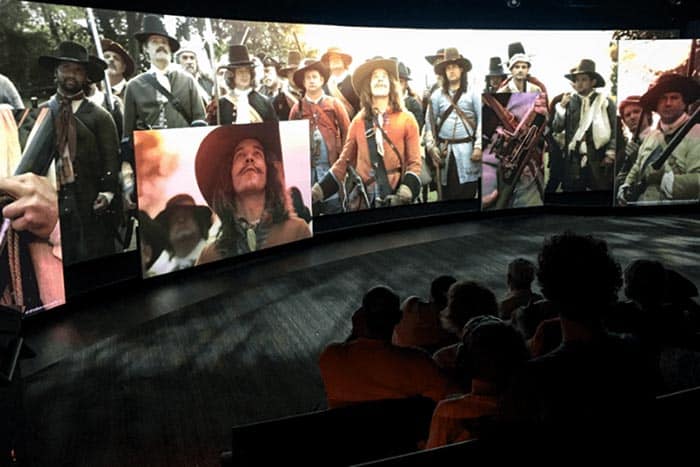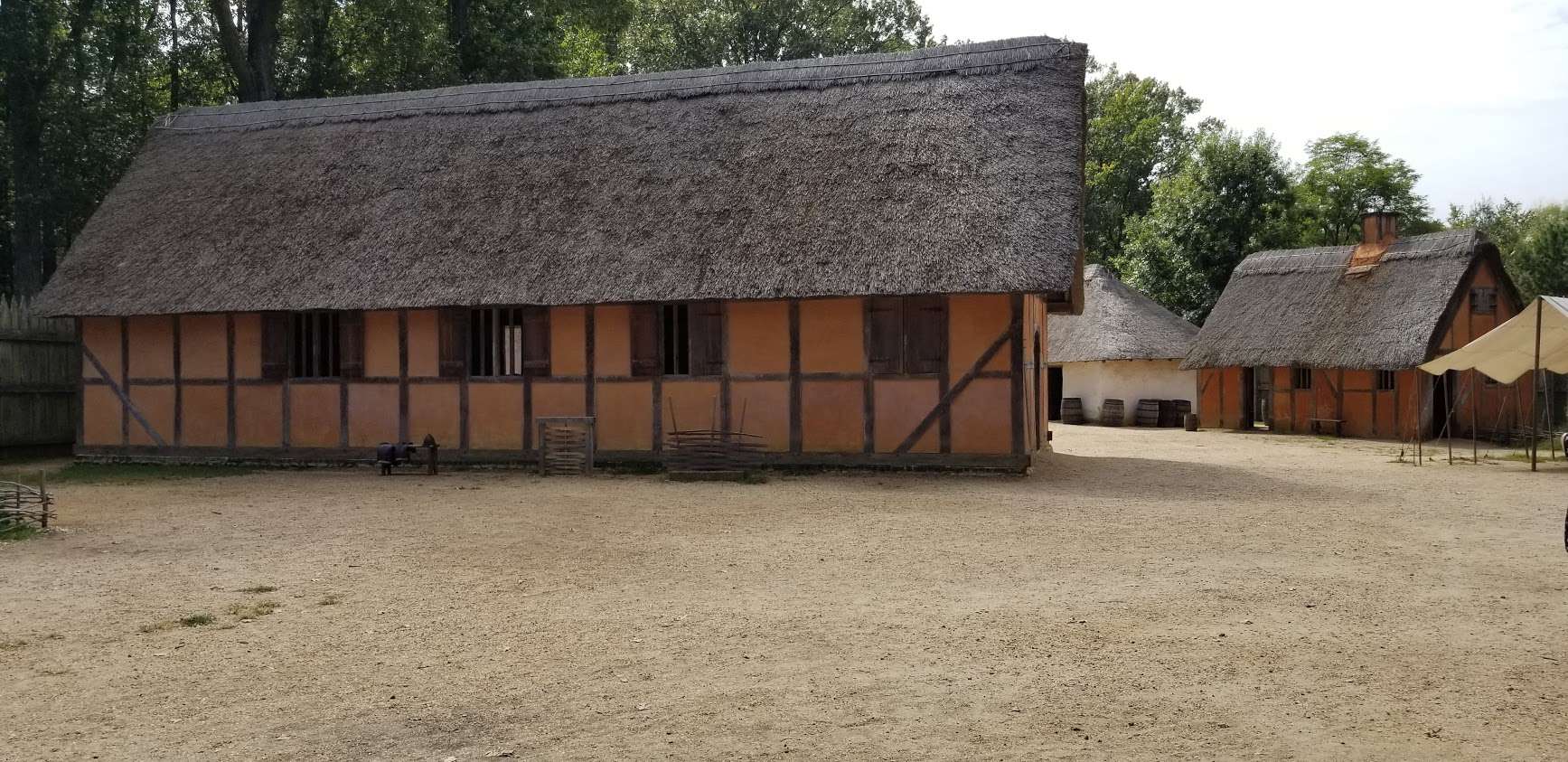
Jamestown and Yorktown Virginia: The Beginning and End of Colonial America
By Jack Dunphy

A visit to the Jamestown Settlement and American Revolution Museum at Yorktown on the Virginia coast is a history lesson at warp speed.
Prepare to soak up the stories of our nation’s founding and have fun doing so. These two museums are nothing like your high school history class. You will feel more like you are climbing up and down and shimmying out onto branches of our national family tree.
These museums are living history sites where visitors actively engage with interpreters as original settlers, Powhatan Indians, and Revolutionary soldiers.
Jamestown Settlement Museum in Virginia
My visit started at the Jamestown Settlement Museum in Williamsburg, VA. It recently underwent a $10.6-million upgrade of its 30,000 square feet exhibit space. Many of the new exhibits are touch screens and interactive. Different rooms present different themes as the

Jamestown story consists of so many stories such as:
- The founding of the first permanent American colony and how it started as a real estate investment by the Virginia Company of England
- Followed by the company’s bankruptcy which left the settlers in dire straights
- The titanic clash of cultures between the English, the Powhatan Indians, and African slaves
- The subjugated role of the English women and their wonderment at seeing Powhatan women leaders negotiate as equals with the English male leaders
- The true story of Pocahontas
- The first legislative assembly in America
- The desperate struggle to survive in such a new and forbidding world
- The history of tobacco and how tobacco saved the colony
If your interests span one or more of these topics you will be richly rewarded.
Dunking Chair
On my walk through the exhibits, I was accompanied by the Curator Kate Gruber. I heartily suggest you arrange for a docent tour as I met several of them here and they all enthusiastically share their history knowledge. Kate explained the difficulties the English women faced in the New World.


She showed me the original 1600s “Dunking Chair.” If a woman was caught gossiping, as determined by a council of men, she would be strapped in the chair and dunked repeatedly under the cold water of the James River as a public spectacle for 30 seconds until nearly drowned. Seeing the actual dunking chair they used gave me shivers.
Powhatan Village
A short path from the exhibit hall is a stroll back through time to a recreated Powhatan village. Interpreters in native dress demonstrate the native lifestyle and their knowledge of native cooking and traditions. I enjoyed sitting in a longhouse and feeling the warmth of the fire and marveling at the ingenuity of the longhouse construction from local reeds.
The Ships of 1607
A walk down the lane and docked in the pretty James River are moored three ships, replicas of the boats that ferried the original settlers on their cramped voyage across the ocean. I climbed aboard the Susan Constant, Godspeed and Discovery. I helped pull up the sail, turned the rudder and soaked in the claustrophobia of a 4-month trip with 144 people and no indoor plumbing. Yikes!
James Fort
Next up the path brought me into the palisaded James Fort. I talked with the 1607 settlers, visited their hand hewed homes and learned the complexity of firing a matchlock musket.
American Revolution Museum at Yorktown

Only 23 scenic miles separate the beginning of colonial America, Jamestown, with the end of colonial America, Yorktown.
The Battle of Yorktown erupted in September 1781, 174 years after the founding of Jamestown. It was the most important, and final battle of the Revolutionary War.
Here I learned our French ally provided critical naval and ground support. In the battle, the French lost 60 men and the Americans 28 men. German soldiers too played a role on all sides.
German mercenaries known as Hessians fought for the British and the French and German Americans fought with Washington.
The 22,000 square foot permanent galleries feature dioramas, short films, period pieces, a copy of the Declaration of Independence printed July 18, 1776, The Treaty of Paris, Article 7, the “American Inspection Roll of Negroes, No. 1,” and the British Book of Negroes, (from the U.S. National Archives in Washington DC and the National Archives, Kew England) in which the British listed the names, ages and potential usefulness of African Americans who escaped to the British side hoping for freedom from slavery.
Glancing down the handwritten Roll of Negroes list I noticed “Philip Scob, age 75, Worn Out.” Chilling.
The Future of Movies

The Yorktown Museum shows the film “The Siege at Yorktown” throughout the day. This film alone is worth the trip.
In the experiential theater, you are not so much watching a movie as you are in it and part of the action. The 180-degree surround sound screen envelopes you in the battle as your seat literally shakes as cannons boom, wind and smoke wash over you, battlefield fake fire seems to singe your face.
Terror of the Battlefield
The terror of battlefield chaos, the fog of war, feels so real here. I knew I had a front-row seat not only to the battle but to the future of filmmaking.
At the Jamestown Museum, they too present an exciting 4D movie, “Bacon’s Rebellion.” This film, recorded in 6k and 8k, projects onto a 51 foot by an 11-foot curved screen. Do yourself a favor and see, I mean experience, them both.

Army Encampment
Outside the exhibit spaces, I walked into an American army encampment. I was intrigued by the series of cooking fires arranged in a wheel—a clever design to feed many hungry soldiers.
Soon a recruiter for the American forces approached me and insisted I enlist to help George Washington’s cause.
Fortunately, I was excused after I explained I suffered from bone spurs in my feet. Thanks, President Trump.
Revolution Farm
The military encampment borders a Revolution-era farm. I asked a historical interpreter in the farm, who was busy tending crops, about the role of tobacco. “It was invaluable,” he said. “For 150 lbs you can buy a bride.”
Tobacco also saved Jamestown Colony, he explained. “John Rolfe, the husband of Pocahontas, illegally obtained valuable sweet tobacco seeds from his Spanish rivals in Trinidad,” he said. The seeds were so highly prized that Rolfe would have been executed by the Spanish if he was caught.

“With this new tobacco strain the settlers grew a cash crop in Jamestown they sent back and sold to England. Tobacco was the holy grail that finally allowed them to become self-sustaining and thrive.”
The Battlefield
I moved onto the battlefield itself. One can still see the redoubts used during the attack.
In the eerie quiet of the field, where men fought hand to hand, I reflected on my visit. I asked myself, “Where would we be today without the French help at Yorktown? Maybe still an English Colony?” So many other questions sprang to mind during my visit.
The staff here are knowledgeable, eager to answer questions, and passionate about their subject. Questions will undoubtedly jump at you throughout your time there and after you get home motivating further exploration.
As I was about to leave Yorktown, I read on a plaque a comment by Benjamin Franklin: “There was never a good war or a bad peace.” Wise Ben summed things up nicely.

Visiting the Sites
Admission: Jamestown $17.50 adults and $8.25 kids 6-12
With Yorktown $26 adults and $12.50 kids
Just Yorktown: $15 adults and $7.50 kids
Open every day except Christmas and New Years
Jamestown and Yorktown Museum website:
Historyisfun.org
More to do:
Visityorktown.org
Where to stay:
Visitwilliamsburg.com
I stayed at the Holiday Inn Express, 480 McLaws Circle, Williamsburg
very clean and comfortable, breakfast included
Places to Eat
Second Street: An American Bistro, 140 2nd St., Williamsburg
757-220-2286 or secondst.com
Excellent ambiance with dinner to match
Riverwalk Restaurant. 323 Water Street, Yorktown
757-875-1522 or Riverwalk Restaurants
Beautiful view looking over the York River
- Corpus Christi Texas Shines with its Art - October 4, 2023
- Beaver Mountain and Cherry Peak in Utah - May 4, 2023
- Las Vegas Reopens: Bigger, Badder, Better - June 21, 2022

